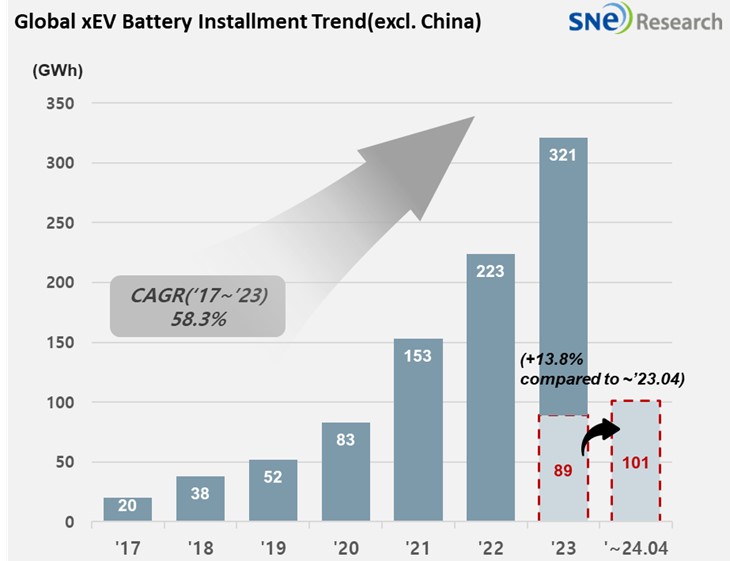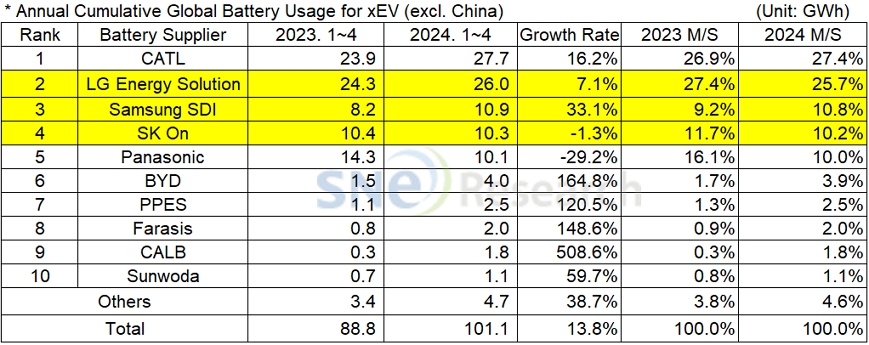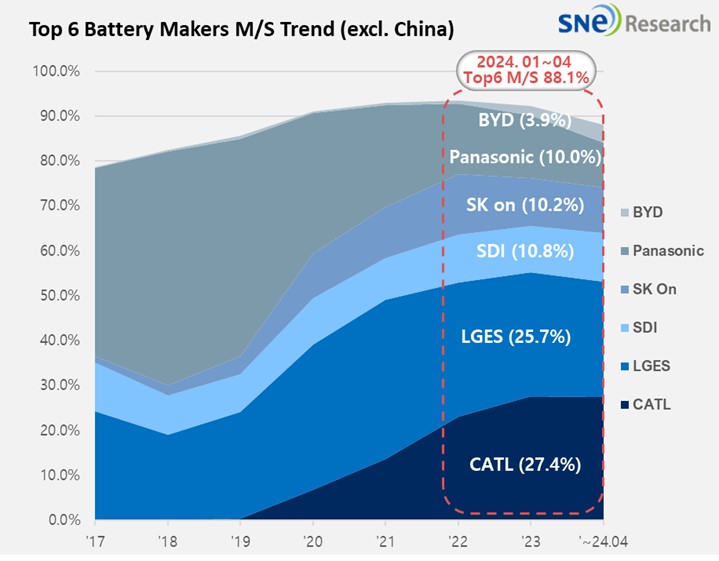From Jan to Apr 2024, Non-Chinese Global[1] EV Battery Usage[2] Posted 101.1GWh, a 13.8% YoY Growth
- K-trio’s combined M/S recorded 46.7% from Jan to Apr 2024
Battery installation for
global electric vehicles (EV, PHEV, HEV) excluding the Chinese market sold from
January to April in 2024 was approx. was 101.1GWh, a 13.8% YoY growth.

(Source:
Global EV and Battery Monthly Tracker – May 2024,
SNE Research)
In the ranking of battery
usage for electric vehicles, the K-trio battery makers all ranked within the
top 5. LG Energy Solution ranked 2nd with a 7.1%(26.0GWh) YoY growth.
Samsung SDI posted the highest growth of 33.1%(10.9GWh) among the K-trio
battery makes while SK On recorded a -1.3%(10.3GWh) YoY growth.

(Source: Global EV and Battery Monthly Tracker – May 2024, SNE Research)
The combined shares of K-trio recorded 46.7%, a 1.6%p YoY decline. If we look at the usage of K-trio battery in light with the sales volume of electric vehicles, Samsung SDI’s strong growth was led by favorable sales of BMW i4/5/X, Audi Q8 e-Tron, and FIAT 500 electric in Europe and the sale of Rivian R1T/R1S in North America. Samsung SDI, targeting the premium electric vehicle battery market both for BEV and PHEV, said that it would expect to see a significant improvement in profit in the entire electric vehicle group from Q2 this year based on its high-value-added battery P5 and P6.
SK On posted a degrowth due to a slowdown in sales of Hyundai IONIQ 5 and EV6 compared to the last year. With SK On’s 4th generation battery to be installed to the recent facelifted models of IONIQ5 and EV6, it is expected that SK On may see a rebound in its battery sales from Q2. Other than them, Ford F-150 and Mercedes EQA/B to which SK On’s battery is installed also recorded solid sales. SK On has reportedly decided to retool its Ford-dedicated battery production line at Plant 1 in the state of Georgia for Hyundai. It also has a plan to start operating the Plant 3 in Hungary with 30GWh capacity. With all of these efforts, SK On is aimed to turning into profit making in the latter half of this year.
LG Energy Solution’s continuous growth was led by favorable sales of Ford’s Mustang Mach-E and GM’s LYRIQ in North America as well as those of Tesla Model 3/Y and Renault’s Megane in Europe. Recently, new models to which batteries, produced by the joint ventures between LG Energy Solution and global OEMs, are installed, have released in the market. For instance, KIA’s compact SUV EV3 was officially launched with NCMA battery cell, manufactured by HLI Green Power – an Indonesia joint venture between LGES and Hyundai Motor Group, installed inside. In addition, KIA’s sedan EV4, slated for launching next year, is expected to have the battery produced by HLI Green Power inside. GM’s Cadillac LYRIQ, released in the Korean market last month, also has NCMA battery cell by Ultium Cells, a joint venture between LGES and GM. With a large 102kWh battery installed, Cadillac LYRIQ can drive up to 465km on a full charge. As the 2nd Ultium Cells plant is planned to increase its production and a new model on the Ultium platform is set to hit stores, LG Energy Solution is forecasted to lead the battery sector in the North American market with its ternary battery, satisfying the IRA regulations.
Panasonic recorded 10.1GWh from Jan to Apr this year in non-China global market, posting a 29.2% YoY degrowth. Major reasons for Panasonic’s degrowth were a slowdown in sales of Tesla Model 3 due to its partial change and the delayed release of Model 3Performance trim to which Panasonic’s battery is installed. As Panasonic is reported to unveil its advanced 2170 and 4680 cells, it is expected to rapidly recover its market share mostly focusing on Tesla.
CATL, rapidly expanding its market share even in the non-China market, captured the top position with a 16.2% (27.7GWh) YoY growth. CATL’s battery is installed to Tesla Model 3/Y (made in China and exported to Europe, North America, and Asia) and vehicle models made by other major OEMs such as BMW, MG, Mercedes, and Volvo. In addition, CATL’s battery is installed to KONA and NIRO by Hyujndai and Ray EV by KIA, meaning that the influence from those Chinese companies has been increasing not only on the global stage but also in the Korean domestic market. Similar to CATL, BYD is threatening other players in the market, continuing to be in high growth in the non-China market. The oversupply issue in the Chinese domestic market is addressed by exporting to overseas markets such as Brazil, Thailand, Israel, and Australia, indicating that the Chinese makers have been expanding their global market shares at a rapid pace.

(Source: Global EV and Battery Monthly Tracker – May 2024, SNE Research)
Similarly, the Chines OEMs take an aggressive stance to address the oversupply issue in the Chinese electric vehicle market by exporting their vehicles to overseas markets. Those electric vehicles from China have price competitiveness compared to the existing OEMs, leading the US and European governments to work intensively on preventing them from entering their markets. With heightened tension against those Chinese electric vehicles, it has become important for the Korean companies to take a leading position in the market and strategically target the overseas market.
[2] Based on battery installation for xEV registered during the relevant period.

